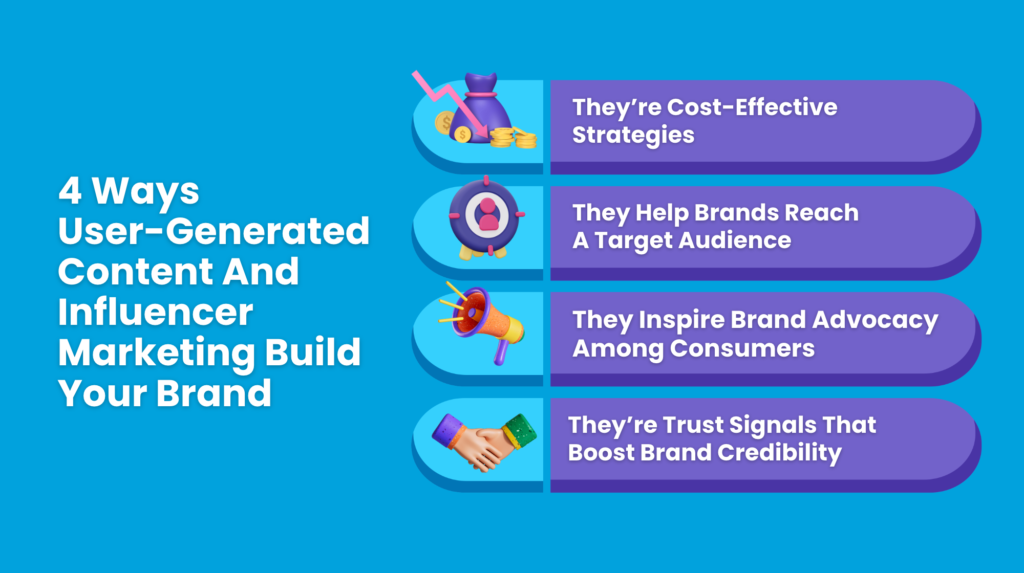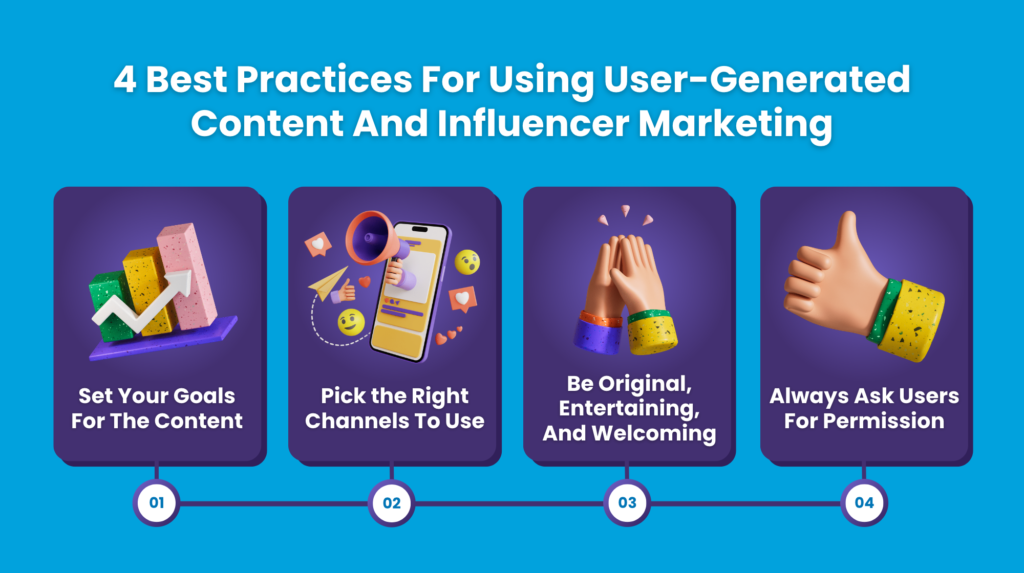Menu

For brands, there’s nothing more authentic than real-life customers taking their time to talk about their product and how it helped them. Influencers are helpful in getting audiences interested in something, but they also sparked the start of a new social marketing era – UGC campaigns.
User-generated content (UGC) refers to videos, reviews, images, and other content consumers publish on social media platforms. Brands often use UGC, along with influencer marketing, to sway the buyer’s purchasing decision in their favor. About 85% of consumers agree that UGC is more compelling for them than brand-created content, so it’s a good strategy to add to your campaign.
Marketers from different industries are always looking for ways to establish and maintain marketing campaigns – but traditional marketing strategies like magazines, newspapers, and television ads won’t cut it anymore.
Nowadays, user-generated content and influencer campaigns are the most effective ways to influence buying decisions, acquire more conversions, and drive sales higher. Although they have their similarities, these marketing tools have distinct differences that make one better than the other in certain cases.
So before you set aside a marketing budget for these techniques, it’s important to understand first what each marketing strategy is and how it can work for the brand.
Both user-generated content and influencer content involves using testimonies from brand ambassadors who can affect the purchase decision of consumers. But the biggest difference between them is that an influencer creates a sponsored post that brands pay for – while UGC is a positive review or testimony made by real customers and posted on social media channels.
For the influencer marketing industry, the focus is on building a relationship between the brand, an online personality, and that influencer’s audience. Influencers create featured videos and take product photos of the product so they can share them with their followers across their own marketing channels. Some industries have natural influencers, like beauticians and makeup artists for the cosmetics industry or celebrity chefs for restaurant trade associations.
On the other hand, user-generated content refers to any type of content created by a user that isn’t part of the brand’s marketing team. It can be anything from product reviews, social posts, social media comments, and more. Although it can affect a consumer’s purchasing decision, UGC isn’t always meant to increase sales – instead, it’s to differentiate the brand from the rest of the competition.
Each content marketing type has its benefits and limitations. It all depends on the brand’s goals when choosing between influencer or UGC campaigns. Here are a few brand goals and how each content marketing strategy helps:
Like influencer campaign strategies, the use of organic UGC is also gaining more momentum across different social channels. But brands should take note that when curating UGC, it’s important to include them in other projects and wider campaign strategies – even the best UGC pieces alone won’t be enough to replace a brand’s entire social media marketing strategy.
Consumers want unique and authentic takes, which makes honest and real customer reviews more important than ever. But there’s also a place for social media posts created by influencers, especially when it comes to establishing awareness and reaching wider audiences.
To achieve the brand’s marketing goals more quickly, it’s best to create a content marketing strategy that uses both UGC and IGC. Always make sure to consider the brand’s marketing goals and the customer’s position in the marketing funnel when planning a strategy.
Customers have different reasons why they feel convinced to try and buy a product after seeing it on social feeds. Nobody can read their minds, but numbers prove that a brand that collaborates with influencers and uses UGC sees better results than a brand promoting its own products.
Influencer campaigns are still on the rise as it’s predicted to grow into a $16.4 billion industry. But instead of celebrities with millions of followers, brands prefer working with micro and nano influencers who bring them as much as 7x more engagement. People also said that they’re more likely to buy a product if it’s endorsed by their favorite influencer.
On the other hand, UGC also does well for itself because people like authentic content from real people. About 90% of millennials prefer “real and organic” over “perfect and packaged” promotions. User content is also 85% better at increasing a brand’s conversion rates than other kinds of studio content.
By nature, most UGC content is at an amateur level – yet it still appeals to more social users who listen to product recommendations from real people like them. If you’re still skeptical about the power of UGC and influencer campaign strategies, here are some convincing ways they help build a brand:

Utilizing UGC campaigns can get a well-planned social media strategy off the ground even with a limited budget. Marketing teams aren’t even required to supervise the production as brand ambassadors create UGC – they just have to curate the content before featuring it in multiple marketing channels.
Although brands still have to hire an influencer to create content for them, it’s still more cost-effective than producing content on their own. Influencers already include the production costs in their fees, so brands don’t have to worry about coming up with a script, editing the video content, or booking a studio for the shoot.
UGC is even more cost-effective because the average cost of encouraging customers to share reviews of them enjoying the product is next to nothing. No need to hire a creative agency for UGC – brands just need to know how to connect with audiences best. Some of them might even be excited to get featured on the brand’s social channels.
Influencers who have a decent number of followers can help brands tap into a new niche group or target audience. They raise awareness for the brand and its products as they produce more content and publish it on their social channels.
As much as influencers are essential for reaching more people, UGC is also important for starting and growing communities. UGC increases the opportunities for consumers to participate in the brand’s growth by allowing them to be a part of a community.
UGC also opens up conversations between brands and consumers about the latter’s suggestions and concerns. This kind of brand interaction fosters more engagement in a community and drives more brand loyalty.
UGC is a powerful marketing tool that turns active customers into brand advocates. Brand advocacy involves customers supporting and recommending a brand they love – whether it’s through referrals, personal recommendations, or other ways.
What’s great about having more brand advocates is that these customers repeatedly buy from the brand and they also encourage others to do the same. But to spark this kind of reaction or movement, it’s crucial for the brand to start interacting with the community first. Customers always give back when they’re put in the spotlight so make sure to comment on and re-share posts from happy clients.
Remember that the bigger an advocate community for the brand is, the more chances are for other people to find out about it.
Lots of people don’t trust advertisers because of the influx of fake news. As a result, brands must work harder to establish themselves as trustworthy – and the best way to do this is to provide social proof through UGC and IGC.
According to 93% of marketers, consumers tend to trust user-generated content more than other projects created by the brands themselves. As for influencer marketing, about 49% of consumers depend on the recommendation of their favorite influencers when purchasing something. This means that UGC and IGC are the best forms of content for businesses to boost their trust score.
Audiences turn to the many forms of UGC in the same way they ask their friends or families for an opinion. Millennials tend to base their decision on product recommendations from their peers and families, so UGC and IGC can act as personal suggestions to them.
Although both UGC and IGC are effective in building awareness, establishing credibility, and securing sales, it’s still important to know how to utilize them to achieve their maximum benefits. Here are some of the best practices to follow when using IGC and UGC on social media and other platforms:

Many brands might be eager to integrate UGC as part of their content strategy, but only a few of them have actual marketing goals for it. Well-known brands establish clear instructions and guidelines first before they share UGC on social media. They often ask their team – what kind of results do we want to achieve for this particular campaign?
Some of the possible marketing goals that the brand can use UGC for are:
A lot of brands make the mistake of only considering 2 things when selecting a social channel to publish UGC: where the audiences are and where the brand advocates have the most influence. Although these aspects are certainly important, it’s still better to consider the UGC’s format and the brand goals when publishing the content.
For example, Facebook is great for sharing customer videos and written testimonies. Instagram works for reposting high-quality images while Instagram stories are for creating ephemeral content. Twitter is the preferred platform for sharing witty quotes from customers while LinkedIn is for sharing case studies and thoughtful articles from niche influencers and customers.
After choosing the right channel to use for a particular UGC, always remember to put relevant hashtags on the caption or post to increase its reach and visibility. It’s also important to tag the original content creators when sharing UGC.
With more brands using UGC as part of their social media strategy, it’s crucial for yours to offer something unique and stand out from the crowd. Think of something that can help build a community so the potential customers feel like they belong.
Take a look at Apple’s Shot on iPhone campaign and GoPro’s Creator Summit. These brands encourage people to celebrate their passion by sharing their content with other people. This kind of UGC campaign is also a win-win situation because it reinforces the values of the brand and displays the raw passion of its audiences, resulting in a stronger sense of community.
When consumers tag the brand in a post, it’s not an excuse for the brand to use the content without permission. It’s always a good idea to talk to the original poster and ask their permission to re-share the content on the brand page.
Doing this helps the brand avoid copyright concerns. It also allows them to show their appreciation to the content creator for sharing their story about the brand. When brands foster good relationships with audiences, they can easily promote brand loyalty and encourage customers to become brand advocates.
Influencer-generated and user-generated content go hand in hand when it comes to boosting brand credibility, fostering audience trust, and increasing social media conversions. Knowing how and when to use each strategy can easily elevate your marketing efforts without having the team create new content from scratch.
Not sure how UGC makes sense for your business? Partnering with the best content team can help you engage audiences and ramp up conversions more effectively.
